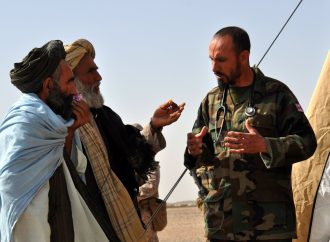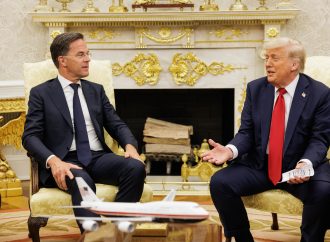In invading Ukraine in both 2014 and 2022, Russia twice contested the now decades-long project that the North Atlantic Treaty Organization (NATO) began in the early 1990’s to construct a European security architecture grounded on shared values rather than historical claims, artificial lines, or spheres of influence.
The Alliance responded by taking steps to shore up NATO’s eastern flank against further Russian aggression and offering significant humanitarian and military assistance to Ukraine and other vulnerable partners (e.g. Bosnia and Herzegovina, Georgia, and the Republic of Moldova). At the same time, the Allies made it clear that, as a NATO partner rather than NATO member, Ukraine does not merit protection under NATO’s Article 5 collective defence guarantee. Although the distinction was drawn partly to remind Putin of the potentially grave consequences of escalating the conflict beyond Ukraine, the war has also laid bare a critical question that NATO must no longer ignore: Just what is it that NATO is defending? Is it simply territory, as the line between partner and member suggests? Or is it the security order that the Allies pledged to pursue in the wake of the Cold War—an order grounded on the liberal democratic principles articulated in the preamble to the NATO treaty and encompassing territory beyond NATO’s traditional sphere of collective defence?
Indeed, even as NATO has issued reminders that Article 5 applies to members only, the Allies have repeatedly characterized Putin’s war on Ukraine as “nothing less than a direct challenge to the rules-based international order,” which they affirmed in NATO’s 2022 strategic concept. That the Allies perceive the possible loss of Ukraine to Russia as having devastating implications for this order is evident in the increasingly advanced capabilities that they have offered Ukraine. French President Emmanuel Macron even went so far as to suggest in late February 2024 that “nothing should be excluded,” including sending troops to Ukraine. His comments, although not supported by most Allies, reflect an awareness that what is at stake is far more than just NATO territory. In short, there is a troubling disconnect between NATO’s professed commitment to a liberal European security order in which all states are free to determine their own futures, and the continuing tendency to seek security through the drawing of lines.
NATO’s Foundational Mission?
Partly, the tension stems from NATO’s repeated failures to clarify the relationship between Article 5 and the Allies’ commitment contained in the preamble to the NATO Treaty “to safeguard the freedom, common heritage and civilisation of their peoples, founded on the principles of democracy, individual liberty and the rule of law.” Although the group of experts shaping NATO’s 2010 strategic concept asserted that “NATO’s Strategic Concept must begin and end with NATO’s founding ideas,” they ultimately failed to elaborate as to how NATO’s core values might inform the Alliance’s collective defence responsibilities.
Similarly, the NATO 2030 report informing the 2022 strategic concept reaffirmed that the preservation of liberal democratic ideals remains NATO’s “foundational mission”; yet, it too failed to address the relationship between these values and the Allies’ responsibilities under Article 5. Is the pledge to safeguard shared values relevant only on the territory of Alliance members? Or is the security of NATO members inseparable from the fate of the broader rules-based international order so intimately connected to NATO’s identity and the Allies’ way of life? Indeed, it’s fair to ask whether NATO’s interests have been well-served by the defence perimeter that it has established around its own territory. That line did not avert and might even have emboldened Putin’s actions in Ukraine. Moreover, even if Putin has refrained from attacking a NATO member state or resorting to the use of nuclear weapons in Ukraine, he has crossed virtually every line delineating acceptable behavior under prevailing international norms, including proper treatment of both soldiers and civilians.
An Increasingly Seamless Security Environment
Additionally, the ongoing war has served to illuminate the interconnected nature of the Euro-Atlantic and Indo-Pacific theaters. Indeed, given its moral and material support for Russia, NATO has characterized the People’s Republic of China as a “decisive enabler of Russia’s war against Ukraine.” North Korea’s recent deployment of troops to Ukraine to fight in Russian uniform only further demonstrates the challenges inherent in compartmentalizing the threats currently facing the Allies.
The increasingly seamless nature of the contemporary security environment is also evidenced by the provision of significant military and humanitarian assistance to Ukraine by NATO’s Indo-Pacific partners (Australia, Japan, New Zealand, and the Republic of Korea), all liberal democracies fearful of the impact of Russian aggression on the rules-based international order in the Indo-Pacific. In fact, former Japanese Prime Minister Fumio Kishida frequently suggested that “Ukraine may be the East Asia of tomorrow,” an argument then echoed by former NATO Secretary General Jens Stoltenberg. Moreover, the Indo-Pacific partners’ repeated references to the liberal democratic values that they share with NATO suggests that they understand the Alliance, not merely as an alliance committed to the defence of its territory, but as an organization that is also foundational to the liberal, rules-based international order.
Indeed, the Allies must ask themselves whether their values and way of life can be secured by defending only their own territory, at a time when Russia, China, and others appear determined to violate the most basic international norms. In short, NATO can no longer ignore the unresolved question at the heart of the NATO treaty: namely, what is it that NATO is ultimately defending? Wrestling with this question is critical to sorting out the nature of NATO’s relationship with Ukraine going forward, as well as the future of partnership and enlargement more broadly. It will likely also determine the extent to which NATO’s core identity in the eyes of its like-minded partners, remains anchored in the liberal values enshrined in the original NATO treaty.
This blog is part of the ‘NATO’s Eastern Flank’ series. Find all of the blogs here.
Learn more about the related conference NATO’s Eastern Flank: Challenges and Implications in the Context of the Ukraine War.









